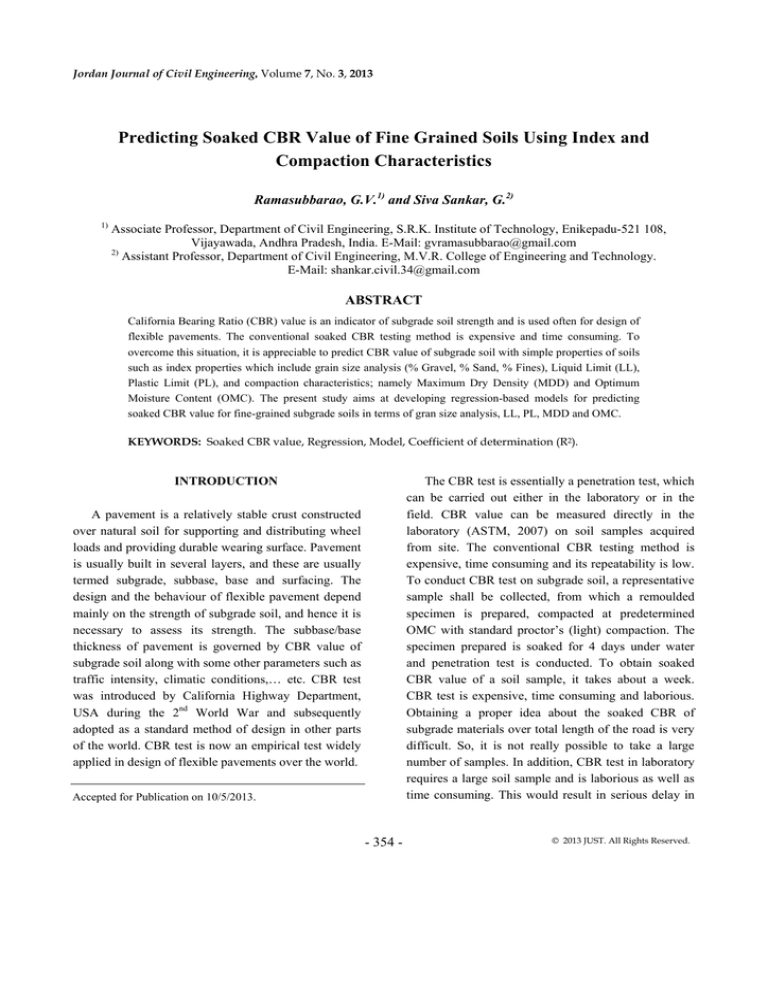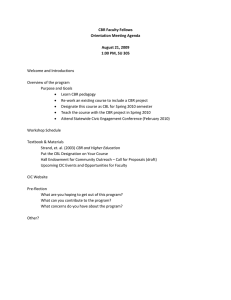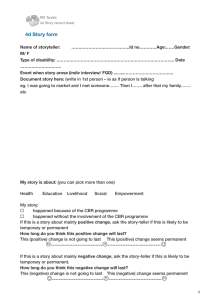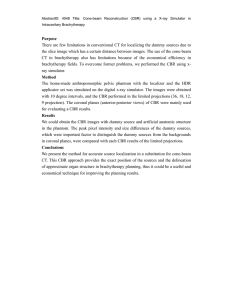
Jordan Journal of Civil Engineering, Volume 7, No. 3, 2013
Predicting Soaked CBR Value of Fine Grained Soils Using Index and
Compaction Characteristics
Ramasubbarao, G.V.1) and Siva Sankar, G.2)
1)
Associate Professor, Department of Civil Engineering, S.R.K. Institute of Technology, Enikepadu-521 108,
Vijayawada, Andhra Pradesh, India. E-Mail: gvramasubbarao@gmail.com
2)
Assistant Professor, Department of Civil Engineering, M.V.R. College of Engineering and Technology.
E-Mail: shankar.civil.34@gmail.com
ABSTRACT
California Bearing Ratio (CBR) value is an indicator of subgrade soil strength and is used often for design of
flexible pavements. The conventional soaked CBR testing method is expensive and time consuming. To
overcome this situation, it is appreciable to predict CBR value of subgrade soil with simple properties of soils
such as index properties which include grain size analysis (% Gravel, % Sand, % Fines), Liquid Limit (LL),
Plastic Limit (PL), and compaction characteristics; namely Maximum Dry Density (MDD) and Optimum
Moisture Content (OMC). The present study aims at developing regression-based models for predicting
soaked CBR value for fine-grained subgrade soils in terms of gran size analysis, LL, PL, MDD and OMC.
KEYWORDS: Soaked CBR value, Regression, Model, Coefficient of determination (R2).
The CBR test is essentially a penetration test, which
can be carried out either in the laboratory or in the
field. CBR value can be measured directly in the
laboratory (ASTM, 2007) on soil samples acquired
from site. The conventional CBR testing method is
expensive, time consuming and its repeatability is low.
To conduct CBR test on subgrade soil, a representative
sample shall be collected, from which a remoulded
specimen is prepared, compacted at predetermined
OMC with standard proctor’s (light) compaction. The
specimen prepared is soaked for 4 days under water
and penetration test is conducted. To obtain soaked
CBR value of a soil sample, it takes about a week.
CBR test is expensive, time consuming and laborious.
Obtaining a proper idea about the soaked CBR of
subgrade materials over total length of the road is very
difficult. So, it is not really possible to take a large
number of samples. In addition, CBR test in laboratory
requires a large soil sample and is laborious as well as
time consuming. This would result in serious delay in
INTRODUCTION
A pavement is a relatively stable crust constructed
over natural soil for supporting and distributing wheel
loads and providing durable wearing surface. Pavement
is usually built in several layers, and these are usually
termed subgrade, subbase, base and surfacing. The
design and the behaviour of flexible pavement depend
mainly on the strength of subgrade soil, and hence it is
necessary to assess its strength. The subbase/base
thickness of pavement is governed by CBR value of
subgrade soil along with some other parameters such as
traffic intensity, climatic conditions,… etc. CBR test
was introduced by California Highway Department,
USA during the 2nd World War and subsequently
adopted as a standard method of design in other parts
of the world. CBR test is now an empirical test widely
applied in design of flexible pavements over the world.
Accepted for Publication on 10/5/2013.
- 354 -
© 2013 JUST. All Rights Reserved.
Jordan Journal of Civil Engineering, Volume 7, No. 3, 2013
statistical parameters such as coefficient of correlation
(R), coefficient of determination (R2) and standard
error reported by earlier investigators are also
presented in the Table 1.
the progress of the project, since in most situations the
materials for earth work construction come from highly
variable sources. Any delay in construction inevitably
leads to rise of project cost. To overcome this situation,
it is better to predict CBR value of subgrade soil with
easily determinable parameters. To exercise the right
judgment during various phases of professional
activities, the engineer is constantly required to predict.
In fact, prediction is an integral component of practice
(Nagaraj et al., 1994).
A few investigators (NCHRP, 2001; Satyanarayana
and Pavani, 2006; Gregory and Cross, 2007; Vinod and
Reena, 2008; Patel and Desai, 2010; Yildrim and
Gunaydin, 2011) in the past developed models for
estimating the CBR value on the basis of low cost, less
time consumption and easiness to perform tests. Other
investigators (Yildrim and Gunaydin, 2011;
Wenkatasubramanian and Dhinakaran, 2011; Saklecha
et al., 2012) used soft computing systems like Artificial
Neural Networks for correlating CBR values with LL,
PL, PI, OMC, MDD and Unconfined Compressive
(UCC) strength values of various soils. In this
investigation, an attempt has been made for correlating
soaked CBR value of fine-grained soils with index
properties such as Grain Size Analysis (% Gravel, %
Sand, % Fines), Plasticity Characteristics (LL and PL)
and Compaction Characteristics; namely MDD and
OMC. The tests conducted for determining grain size,
LL, PL, MDD and OMC are much cheaper and lesstime consuming than soaked CBR test. The correlation
is established in the form of an equation of soaked
CBR value as a function of different soil properties by
regression analysis.
Proposed Model for Estimating Soaked CBR Value
In this study, regression models, both simple linear
and multiple linear, were developed for estimating
soaked CBR value in terms of index and compaction
characteristics. Data pertaining to soil properties used
for developing models to estimate soaked CBR value is
presented in Table 2. The index properties of soils
show that all the soils used for developing models are
fine-grained soils (ASTM, 2010). The range of
parameters studied in this investigation is: Gravel=024%, Sand=0-40.14%, Fines (Silt+Clay) =50-100%,
LL=24.6-94.0%,
PL=11.9-36.0%,
MDD=1.251.85g/cc, OMC=12.3-35.4%, soaked CBR=0.8-5.86%.
A wide range of fine grained soils are selected while
developing models to predict soaked CBR value of
subgrade soil.
Simple Linear Regression Analysis (SLRA)
To develop the models, simple linear regression
analysis and multiple linear regression analysis were
carried out. Soaked CBR value is considered as
independent variable and Gravel (G), Fines (F), Sand
(S), LL, PL, MDD and OMC are considered as the
dependent variables. Simple Linear Regression
Analysis (SLRA) has been carried out to develop the
correlation between individual soil property and soaked
CBR value. SLRA can be carried out using standard
statistical software like Data Analysis Tool Bar of
Microsoft Excel in order to derive the relationship
statistically. Statistical parameters of soaked CBR
value predicted by various SLRA models are presented
in Table 3.
From Table 3, it is noticed that model 6 has given a
good performance as it has the highest coefficient of
correlation (R)-value of 0.91, coefficient of
determination (R2)-value of 0.84 and least standard
error of 1.23. Correlation and linear regression are not
Existing Models to Estimate CBR
Attempts have been made by several researchers to
develop suitable correlation between CBR value of
compacted soils and different soil characteristics. The
details of the existing models proposed by several
researchers and the parameters considered for
developing those models are presented in Table 1. The
- 355 -
Predicting Soaked CBR…
Ramasubbarao, G.V. and Siva Sankar, G.
the same. Correlation quantifies the degree to which
dependent and independent variables are related.
Coefficient of correlation tells how much one variable
tends to change when the other one does. When R is
0.0, there is no relationship. When R is 1, there is a
good relation. Linear regression quantifies goodness of
fit with r2, sometimes shown in upper case R2. R2-value
provides a measure of how well future outcomes are
likely to be predicted by the model. Any correlation
with R2 value equal to 0.80 or above will be viewed as
a best fit. Models 5, 1, 7, 2, 4 and 3 have performed in
descending order by observing decreasing order of Rvalue and R2-value.
Table 1. Models Proposed by Earlier Investigators
S.No.
1
Parameters
considered
and their range
(NCHRP, 2001) non-plastic coarsegrained soils
Investigator
plastic, fine-grained
soils
2
3
4
5
6
(Satyanarayana FF=9.0-34.8%,
Reddy & Pavani, LL=22-48%,
2006)
MDD=1.90-2.32g/cc,
CBRs=12.8-56.8%
(Gregory &
For cohesive soils
Gross, 2007)
For cohesionless soils
(Vinod & Reena, C=33-65%,
2008)
LL=38.10-63.00%,
CBRs=8.9-30.4%
LL=52.98-70.78%,
PL=17.09-26.8%,
(Patel
SL=8.03-19.5%,
&
MDD=1.58-1.73g/cc,
Desai, 2010)
OMC=17.23-24.70%,
PI=24.19-47.78%,
CBRu=2.80-8.94%,
CBRs=1.54-4.42%
(Yildirim &
G=0-78%, S=1-49%,
Gunaydin,
F=10-99%, LL=202011)
89%, PL=11-43%
MDD=1.21-2.18 g/cc,
OMC=7.20-40.20%
Model
CBR = 5%, if D60≤0.01mm
CBR=28.09(D60)2, if 0.01mm≤D60≤30mm
CBR=95%, if D60≥30mm
75
CBR
1 0.728(wPI )
CBRs=-0.388F-0.064LL+20.38MDD
CBR = 0.09 cu
CBR
qult *100
6895
CBRs= -0.889(WLM)+45.616
where, WLM = LL (1 – C/100)
CBRu=17.009-0.0696Ip-.296MDD+0.0648OMC
CBRs=43.907-0.093Ip-18.78MDD-0.3081OMC
Statistical
parameter
R2=0.84
R2=0.67
R=0.96
R=0.979
% error=-2.5%
% error=-5%
CBR = 0.2353G+3.0798
R2=0.86
CBR=-0.1805F+18.508
R2=0.80
CBR=0.22G+0.045S+4.739MDD+0.122OMC
CBR=0.62OMC+58.9 MDD+0.11LL+0.53PL126.18
R2=0.88
R2=0.63
Where, CBRs = Soaked California Bearing Ratio, CBRu = Unsoaked California Bearing Ratio, D60 = Diameter at 60% passing from
grain size distribution (in mm), w = Percentage passing No.200 U.S. sieve (in decimal), LL= Liquid Limit of soil (in percent) and C
is fraction of soil coarser than 425micron (percent), PL=Plastic Limit, SL=Shrinkage Limit, Ip =PI=Plasticity Index,
MDD=Maximum Dry Density, OMC = Optimum Moisture Content (%), cu= undrained cohesion (kPa), qult=Ultimate bearing
capacity (in kPa).
- 356 -
Jordan Journal of Civil Engineering, Volume 7, No. 3, 2013
Table 2. Data Used for Developing Models to Estimate Soaked CBR Value
Compaction
Characteristics
OMC
(%)
MDD
(g/cc)
Soaked
CBR
Value
(%)
CH
16.8
1.78
3.00
16.48
CH
17.0
1.64
1.47
60.60
30.60
CH
35.0
1.51
1.96
0.00
63.00
31.00
CH
35.0
1.25
1.26
5.60
0.00
72.70
30.50
CH
21.2
1.85
2.10
65.50
32.50
2.00
82.50
32.80
CH
19.6
1.58
0.80
7
89.00
11.00
0.00
94.00
36.00
CH
35.4
1.33
2.10
8
89.00
11.00
0.00
75.00
32.00
CH
28.0
1.47
2.43
9
91.00
9.00
0.00
48.00
26.00
CL
20.0
1.61
3.40
10
71.00
27.00
2.00
49.00
24.00
CL
19.6
1.69
4.13
11
52.00
39.00
9.00
59.00
34.00
CH
19.0
1.69
4.00
12
100.00
0.00
0.00
47.20
32.00
CL
23.0
1.55
4.90
13
60.00
18.00
22.00
24.60
15.30
CL
18.5
1.56
2.34
14
57.00
24.00
19.00
29.30
18.40
CL
18.2
1.71
2.55
15
57.00
19.00
24.00
26.00
11.90
CL
15.2
1.63
2.12
16
54.00
28.00
18.00
30.00
12.30
CL
14.2
1.82
3.14
17
83.00
17.00
0.00
36.50
20.90
CL
16.2
1.76
3.94
18
66.67
33.30
0.00
34.04
25.75
ML
18.9
1.52
5.86
19
61.50
35.50
3.00
45.20
22.30
CL
12.3
1.78
3.3
20
74.00
26.00
0.00
56.00
27.00
CH
24.8
1.51
3.89
21
79.00
21.00
0.00
59.00
31.00
MH
26.1
1.47
3.57
22
92.00
8.00
0.00
57.80
21.70
CH
22.0
1.58
1.5
23
87.00
13.00
0.00
32.60
20.60
CL
15.0
1.84
1.31
24
59.86
40.14
0.00
43.50
26.78
ML
21.6
1.61
3.27
25
97.00
3.00
0.00
69.00
33.00
CH
26.8
1.55
2
S.
No.
Fines
(%)
Sand
(%)
Gravel
(%)
LL
(%)
PL
(%)
Soil
Type
1
62.50
37.50
0.00
54.80
27.40
2
60.40
34.58
5.02
58.70
3
94.40
5.60
0.00
4
91.50
8.50
5
94.40
6
soil properties as dependent variables. MLRA can be
carried out using standard statistical software like Data
Analysis Tool Bar of Microsoft Excel in order to derive
the relationship statistically. Soaked CBR (CBRs) may
Multiple Linear Regression Analysis (MLRA)
MLRA has been carried out by considering soaked
CBR value as the independent variable and the rest of
- 357 -
Predicting Soaked CBR…
Ramasubbarao, G.V. and Siva Sankar, G.
be expressed as given below:
CBRs=0.064F+0.082S+0.033G-0.069LL+0.157PL1.810MDD-0.061OMC…… (1)
CBRs = f (F, S, G, LL, PL, MDD, OMC)
Table 3. Models Developed from Simple Linear Regression Analysis
Type of
RA
SLRA
SLRA
SLRA
SLRA
SLRA
SLRA
SLRA
Statistical Parameters
Model No.
1
2
3
4
5
6
7
Model
CBRs=0.035F
CBRs= 0.1085S
CBRs= 0.144G
CBRs=0.045LL
CBRs = 0.103PL
CBRs = 1.737MDD
CBRs = 0.116OMC
R
R2
0.88
0.84
0.40
0.82
0.89
0.91
0.85
0.78
0.70
0.16
0.68
0.79
0.84
0.73
Adjusted
2
R
0.74
0.66
0.12
0.64
0.75
0.80
0.69
Standard
Error
1.43
1.69
2.85
1.76
1.39
1.23
1.60
Table 4. Analysis of Variance (ANOVA) for Testing Significance of Regression
Degree
Source of Variation
Regression
Error or Residual
Total
of
freedom
(df)
7
18
25
Sum of
Squares
Mean Square (MS)
F= MSR/MSE
MSR =217.0522/7=31.007
MSE =17.15102/18= 0.952
=31.007/0.952
=32.542
(SS)
217.0522
17.15102
234.2032
The statistical parameters indicate that the best
performance can be obtained from MLRA rather than
SLRA by showing the highest R-value of 0.96 and
R2-value of 0.92. Hence, the above model may be
proposed for estimating soaked CBR value. To
measure the adequacy of the proposed model for
estimation of CBR value, F-test is performed according
to the standard procedure (Montgomery and Runger,
2003). To test the significance of regressions, analysis
of variance (ANOVA) was employed. This test follows
an F-distribution with degree of freedom (d.o.f) ν1=7
and ν2=18 for CBR, so that the critical region will
consist of a value exceeding 2.58. In this test, a 95%
- 358 -
level of confidence was chosen. If the calculated F
value is greater than the tabulated F value, the null
hypothesis is rejected and there is a real relation
between dependent and independent variables. Since
the calculated F value (=32.542) is greater than the
tabulated F value (F0.05, 7, 18=2.58), the null hypothesis
is rejected. Therefore, it is concluded that the model is
valid.
Validity of the Proposed Model
The validity of the proposed model for prediction of
soaked CBR value was verified by data of soil
properties reported by few investigators. The results of
Jordan Journal of Civil Engineering, Volume 7, No. 3, 2013
the predicted and observed soaked CBR values are
presented in Table 5. The soaked CBR value was
predicted using the proposed regression model given
by equation (1). It is found that the observed soaked
CBR value and the predicted CBR values are close to
each other. The proposed model should only be used
along with good judgment and engineering experience
to provide a rapid and cost-effective method of
determining soaked CBR of subgrade soil.
Table 5. Validity of Proposed Model
Investigator
Fines (%)
Sand (%)
Gravel (%)
LL (%)
PL (%)
OMC (%)
MDD (g/cc)
Predicted CBRs Value (%)
Observed CBRs Value (%)
Ratio of Predicted CBRs to
Observed CBRs
(El-Rawi &
(El-Rawi &
(Mohanty
(Reddy
Al-Samadi,
Al-Samadi,
et al.,
et al.,
1995)
89
11
0
52
29
22.7
1.54
3.38
3.8
1995)
97
3
0
51
24
20.5
1.67
2.42
2.5
2011)
92.56
7.44
0
33.45
22.24
17
1.72
3.57
3.28
2011)
54
43
3
42
22
14.6
1.8
3.50
3.8
0.89
0.96
1.09
0.92
developed using Multiple Linear Regression
Analysis (MLRA) by showing the highest R-value
of 0.96 and R2 - value of 0.92 and the lowest error
of 0.97.
4. It was observed that the use of index properties
such as grain size analysis (%Gravel, %Sand,
%Fines), Plasticity Characteristics (LL, PL) and
Compaction Characteristics; namely MDD and
OMC appears to be reasonable in the estimation of
soaked CBR value of fine grained soils.
CONCLUSIONS
The following conclusions can be drawn from the
results of the present study:
1. The statistical parameters indicate that the model
developed by Simple Linear Regression Analysis
(SLRA) for correlating soaked CBR value with
Maximum Dry Density (MDD) has shown better
performance.
2. The other models developed by SLRA for
correlating soaked CBR value with Plastic Limit
(PL), %Fines (F), %Sand (S), Liquid Limit (LL)
and Optimum Moisture Content (OMC) have
shown relatively good performances.
3. The statistical parameters indicate that better
performance can be obtained from the model
Acknowledgements
Authors are grateful to Prof. K. Mallikarjuna Rao,
Department of Civil Engineering, Sri Venkateswara
University College of Engineering, Tirupati, Andhra
Pradesh, India for his constant motivation and
guidance.
- 359 -
Predicting Soaked CBR…
Ramasubbarao, G.V. and Siva Sankar, G.
REFERENCES
ASTM D1883-07e2. 2007. Standard Test Method for CBR
(California Bearing Ratio) of Laboratory-Compacted
Soils, American Society for Testing of Materials,
Pennsylvania, USA.
ASTM D2487-10. 2010. Standard Practice for
Classification of Soils for Engineering Purposes
(Unified Soil Classification System), American Society
for Testing of Materials, Pennsylvania, USA.
El-Rawi, N.M. and Al-Samadi, M.M.Y. 1995.
Optimization of Cement-Lime-Chemical Additives to
Stabilize Jordanian Soils, Journal of Islamic Academy
of Sciences, 8 (4): 167-174.
Gregory, G.H. and Cross, S.A. 2007. Correlation of CBR
with Shear Strength Parameters, June 24-27, 1-14,
Proceedings of 9th International Conference on Low
Volume Roads, Austin, Texas.
Mohanty, B., Chauhan, M.S. and Mittal, S. 2011.
California Bearing Ratio of Randomly Oriented Fiber
Reinforced Clayey Subgrade for Rural Roads, Dec. 1517, 611-614, Proceedings of Indian Geotechnical
Conference-2011, Kochi, India.
Montgomery, D.C. and Runger, G.C. 2003. Applied
Statistics and Probability for Engineers, 3rd Edn., John
Wiley and Sons, Inc.
Nagaraj, T.S., Srinivasa Murthy, B.R. and Vatsala, A.
1994. Analysis and Prediction of Soil Behavior, First
Edition, New Age International Publishers, New Delhi,
India.
National Cooperative Highway Research Program
(NCHRP). 2001. Guide for Mechanistic and
Empirical–Design for New and Rehabilitated Pavement
Structures, Final Document, Appendix CC-1:
Correlation of CBR Values with Soil Index Properties,
West University Avenue Champaign, Illinois, USA.
- 360 -
Patel, S.R. and Desai, M.D. 2010. CBR Predicted by Index
Properties for Alluvial Soils of South Gujarat, Dec. 1618, 79-82, Proceedings of Indian Geotechnical
Conference–2010, India.
Reddy, C.N.V.S., Reddy, K.C. and Kumar, T.K. 2011.
Reinforced Soil Mattress Approach for Flexible
Pavements over Clay Subgrade, Dec. 15-17, 601-603,
Proceedings of Indian Geotechnical Conference-2011,
Kochi, India.
Saklecha, P.P., Katpatal, Y.B., Rathore, S.S. and Agarwal,
D.K.
2012.
ANN
Modeling
for
Strength
Characterization of Subgrade Soil in a Basaltic Terrain,
Proceedings of ICAMB-2012, Jan. 9-11, 1215-1220,
SMBS, VIT University, Vellore, India.
Satyanarayana Reddy, C.N.V. and Pavani, K. 2006.
Mechanically Stabilised Soils-Regression Equation for
CBR Evaluation, Dec. 14-16, 731-734, Proceedings of
Indian Geotechnical Conference-2006, Chennai, India.
Venkatasubramanian, C. and Dhinakaran, G. 2011. ANN
Model for Predicting CBR from Index Properties of
Soils, International Journal of Civil and Structural
Engineering, Integrated Publishing Association (IPA),
2 (2): 605-611.
Vinod, P. and Reena, C. 2008. Prediction of CBR Value of
Lateritic Soils Using Liquid Limit and Gradation
Characteristics Data, Highway Research Journal, IRC,
1 (1): 89-98.
Yildrim, B. and Gunaydin, O. 2011. Estimation of CBR by
Soft Computing Systems, Expert Systems with
Applications, ELSEVIER, 38 (2011): 6381-6391.



